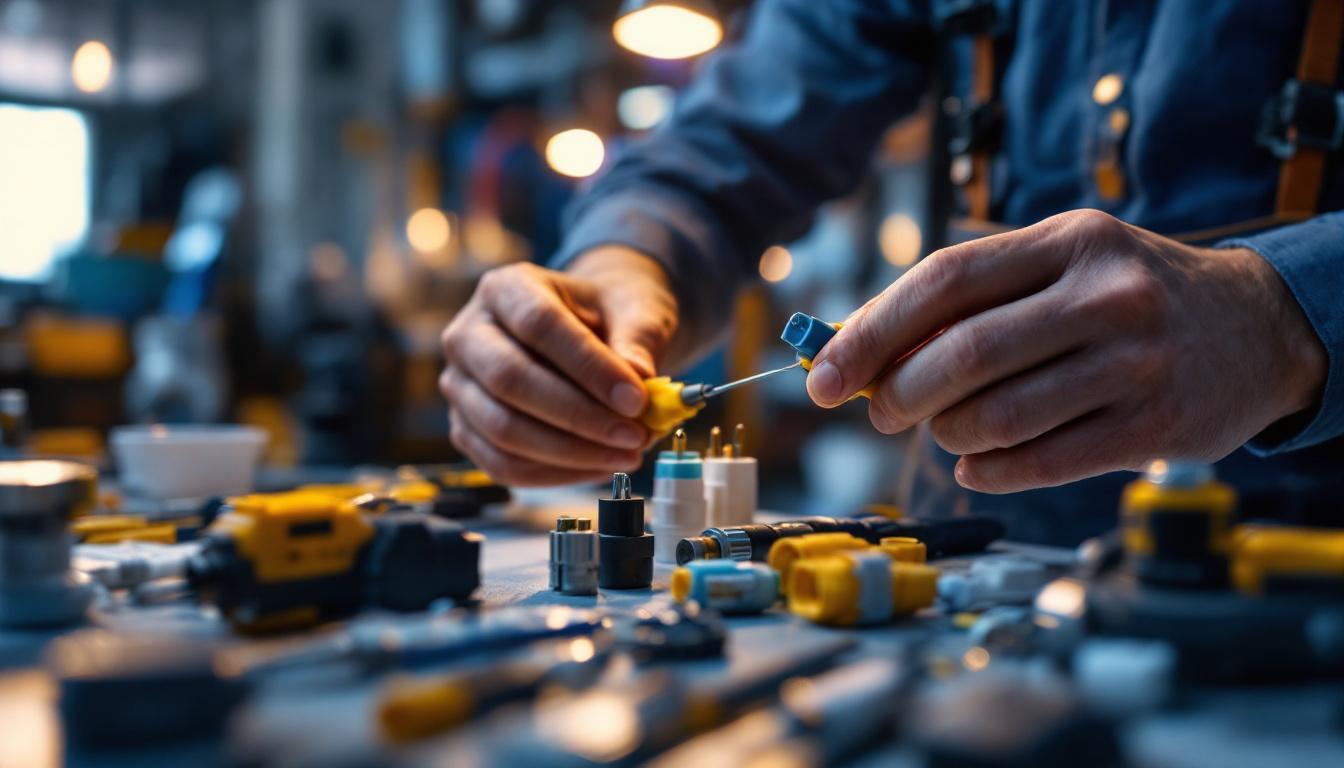
In the world of lighting design and installation, understanding the nuances of light switches and plug combinations is crucial. For lighting contractors, training your team effectively on these components can significantly enhance their skill set, leading to better installations and satisfied clients. This article delves into the importance of training your team in lighting, focusing on the intricacies of light switch and plug combinations.
Training is not just about compliance; it’s about fostering a culture of excellence. Proper training in lighting can lead to improved safety, efficiency, and quality of work. When teams are well-versed in the technical aspects of light switches and plugs, they are better equipped to handle diverse projects and challenges.
Safety is paramount in any electrical work. When your team understands the correct usage and installation of light switches and plugs, the risk of accidents decreases significantly. Training should emphasize the importance of adhering to safety protocols, such as ensuring that circuits are de-energized before work begins and using appropriate personal protective equipment (PPE).
Moreover, knowledge of local codes and regulations regarding electrical installations is essential. This ensures that all work meets legal standards, protecting both the contractor and the client from potential liabilities. Regular safety drills and workshops can reinforce these principles, allowing team members to practice emergency procedures and stay updated on the latest safety technologies and practices.
Well-trained teams can complete tasks more efficiently. Familiarity with light switch and plug combinations allows your team to work quickly without compromising quality. Training sessions that focus on practical applications can help team members become adept at identifying the right components for various projects, thus streamlining the installation process.
Efficiency also extends to troubleshooting. A team that understands the intricacies of lighting systems can quickly diagnose and resolve issues, minimizing downtime and enhancing customer satisfaction. Incorporating hands-on training with real-world scenarios can further enhance problem-solving skills, enabling team members to think critically and adapt to unexpected challenges on the job site.
Clients appreciate contractors who demonstrate expertise and professionalism. When your team is knowledgeable about light switches and plug combinations, they can provide informed recommendations and solutions to clients. This not only builds trust but also fosters long-term relationships.
Additionally, a well-trained team can communicate effectively with clients, explaining the benefits of different lighting options and addressing any concerns they may have. This level of engagement can set your business apart in a competitive market. By offering personalized consultations and tailored solutions, your team can ensure that clients feel valued and understood, paving the way for repeat business and referrals. Furthermore, incorporating feedback mechanisms after project completion can help refine services and strengthen client loyalty, as it shows a commitment to continuous improvement and customer satisfaction.
Understanding the components of light switches and plugs is fundamental for any lighting contractor. This knowledge forms the basis of effective training programs that can equip your team with the skills they need. A well-rounded understanding not only boosts the confidence of your team but also ensures that installations are completed efficiently and safely, reducing the likelihood of costly mistakes.
There are various types of light switches, each serving a specific purpose. Familiarity with these types can help your team make informed choices during installations. Common types include single-pole switches, three-way switches, and dimmer switches.
Single-pole switches are the most basic and are used to control a light fixture from one location. Three-way switches allow control from two different locations, which is particularly useful in larger spaces. Dimmer switches offer the ability to adjust the brightness of lights, adding versatility to any lighting design. Training should include hands-on experience with these switches to reinforce understanding. Additionally, your team should explore newer technologies such as smart switches, which can be controlled via smartphones or voice commands, reflecting the growing trend towards home automation.
Plug combinations are equally important in the context of lighting. Different plugs serve various functions and are designed for specific applications. For instance, standard plugs are common in residential settings, while specialized plugs may be used for commercial or industrial applications.
Training should cover the types of plugs available, their ratings, and the appropriate contexts for their use. This knowledge ensures that your team can select the right plug for each installation, enhancing both safety and functionality. Moreover, understanding the differences between polarized and non-polarized plugs, as well as the significance of plug ratings, can prevent electrical mishaps and ensure compliance with local codes and regulations, which is crucial for maintaining a good reputation in the industry.
Proper wiring techniques are essential for the successful installation of light switches and plugs. Training should include instruction on how to safely and effectively wire these components, including understanding color codes and the significance of grounding.
Hands-on practice with wiring can greatly enhance your team’s confidence and competence. By simulating real-world scenarios, team members can learn to troubleshoot common issues and develop problem-solving skills that will serve them well in the field. Furthermore, incorporating lessons on the latest wiring technologies, such as low-voltage wiring and energy-efficient systems, will prepare your team for the future of electrical installations. Understanding these advanced techniques can also open up new opportunities for projects that prioritize sustainability and energy conservation, making your team more competitive in a rapidly evolving market.
Implementing effective training methods is crucial for ensuring that your team retains the information they learn. A combination of theoretical knowledge and practical application will yield the best results.
Workshops provide an excellent opportunity for hands-on training. These sessions can focus on specific aspects of light switches and plugs, allowing team members to practice installation techniques in a controlled environment. Incorporating real-life scenarios can make the training more relatable and effective.
During these workshops, encourage team members to ask questions and share their experiences. This collaborative approach can foster a deeper understanding of the material and create a supportive learning environment. Additionally, consider inviting guest speakers or industry experts to share their insights and experiences, which can further enrich the learning experience. By exposing your team to diverse perspectives, you can spark innovative thinking and problem-solving skills that are essential in the field.
In today’s digital age, online training resources can complement in-person workshops. Various platforms offer courses on electrical systems, lighting design, and installation techniques. Utilizing these resources can provide your team with flexibility in their learning and allow them to revisit complex topics as needed.
Encourage team members to take advantage of webinars, instructional videos, and online forums. These resources can be particularly beneficial for those who may need additional support or prefer self-paced learning. Furthermore, consider creating a centralized online repository where team members can access curated materials, including articles, case studies, and best practice guides. This can serve as a valuable reference point and promote a culture of continuous improvement within your organization.
Establishing a mentorship program can be an effective way to enhance training. Pairing less experienced team members with seasoned professionals can facilitate knowledge transfer and skill development. Mentors can provide guidance, answer questions, and offer insights based on their own experiences.
This approach not only benefits the mentees but also reinforces the mentors’ knowledge and skills. It fosters a culture of continuous learning and collaboration within your team. To maximize the effectiveness of mentorship, consider setting clear goals and expectations for both mentors and mentees. Regular check-ins can help track progress and ensure that the relationship remains productive. Additionally, incorporating feedback mechanisms can help refine the program and address any challenges that may arise, ultimately leading to a more robust training experience for everyone involved.
To ensure that your training programs are effective, it is essential to evaluate their impact. Regular assessments can help identify areas for improvement and ensure that your team is retaining the knowledge they acquire.
Implementing feedback mechanisms is crucial for gauging the effectiveness of training. Encourage team members to share their thoughts on the training sessions, including what they found helpful and what could be improved. This feedback can provide valuable insights into the training process.
Consider conducting surveys or holding debriefing sessions after training workshops. This open dialogue can help create a culture of continuous improvement and ensure that training remains relevant and effective.
Regular performance assessments can also help evaluate the effectiveness of training. Monitor team members’ performance on the job, paying attention to their ability to apply what they have learned. This can include observing their installation techniques, troubleshooting skills, and overall efficiency.
Recognizing improvements in performance can reinforce the value of training and motivate team members to continue developing their skills.
Encouraging continuous learning is vital in the ever-evolving field of lighting. Stay updated on industry trends, new technologies, and emerging best practices. Provide opportunities for your team to attend industry conferences, trade shows, and additional training sessions.
By fostering a culture of continuous learning, you can ensure that your team remains at the forefront of the industry, equipped with the latest knowledge and skills to excel in their roles.
Training your team in light switch and plug combinations is an investment that pays dividends in safety, efficiency, and client satisfaction. By focusing on the importance of proper training, understanding key components, and implementing effective training methods, lighting contractors can empower their teams to excel in their work.
As the lighting industry continues to evolve, staying informed and adaptable is crucial. By fostering a culture of continuous learning and improvement, contractors can ensure that their teams are well-prepared to meet the challenges of the future.
In summary, a well-trained team is not just a benefit; it’s a necessity in the competitive landscape of lighting installation. By prioritizing training, contractors can enhance their reputation, improve their service offerings, and ultimately drive business success.
Ready to elevate your lighting installations and empower your team with the highest quality products? Look no further than LumenWholesale for all your lighting needs. Our spec-grade lighting products are designed to meet the rigorous demands of any project, ensuring you deliver exceptional results every time. With unbeatable wholesale prices and the convenience of free shipping on bulk orders, you can trust LumenWholesale to provide the best value without any hidden fees. Don’t let middleman markups affect your bottom line. Choose LumenWholesale for reliable, high-performance lighting solutions that combine quality, affordability, and convenience. Wholesale Lighting at the Best Value is just a click away.

Discover the innovative alternatives to traditional can lights that lighting contractors swear by.

Discover essential tips and insights for lighting contractors to navigate the latest trends while avoiding common pitfalls.

Explore the advantages and drawbacks of outdoor light brackets for lighting contractors.

Discover top strategies for different wire connectors used by lighting contractors.